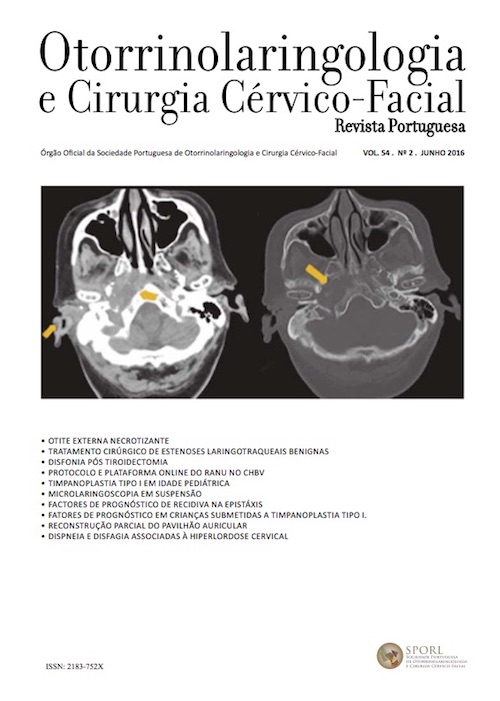Type I tympanoplasty in children: Our results
DOI:
https://doi.org/10.34631/sporl.357Keywords:
Tympanic Membrane Perforation, Type I Tympanoplasty, PediatricAbstract
Objectives: To evaluate the type I tympanoplasty results in children and to analyze some factors referred as potential determinants in their success.
Study Design: Observational, analytical and retrospective study
Material and Methods: Analysis of 22 clinical cases of pediatric patients (<18 years) undergoing primary type I tympanoplasty in Centro Hospitalar do Porto, between 01/01/2013 and 01/31/2014. We collected and analyzed individual variables and determined of the corresponding anatomical and functional success rate.
Results: An anatomical success rate of 73% and functional success of 82% was obtained (mean follow-up: 16.77 ± 07.11 months). Success rates were not significantly different between the two age groups analyzed. The lowest anatomical success rate in larger perforations was statistically significant.
Conclusions: The success rates obtained are consistent with the results described in the literature. In this study the only variable related to anatomic and functional failure was the size of the perforation.
Downloads
References
Collins WO, Telischi FF, Balkany TJ, Buchman CA. Pediatric Tympanoplasty: Effect of contralateral ear status on outcomes. Arch Otolaryngol Head Neck Surg. 2003;129(6):646-651.
Geros S, Ribeiro D, Castro F, Robles R, et al. Timpanoplastia tipo I pediátrica: definição de sucesso e factores que afectam o prognóstico. Cadernos de Otorrinolaringologia. 2014. http://www.cadernosorl.com/artigos/15/8.pdf Acedido em Janeiro 15, 2015.
Sarkar S, Roychoudhury A, Roychaudhuri BK. Tympanoplasty in Children. Eur Arch Otorhinolaryngol. 2009;266:627-633.
Boronat-Echeverría NE, Reyes-Garcia E, Sevilla-Delgado Y, Aguirre-Mariscal H, et al. Prognostic factors of sucessful tympanoplasty in pediatric patients: a cohort study. BMC Pediatrics. 2012;12:67.
Vrabec JT, Deskin RW, Grady JJ. Meta-analysis of Pediatric Tympanoplasty. Arch Otolaryngol Head Neck Surg. 1999;125(5):530-534.
Duval M, Grimmer JF, Meier J, Muntz R, et al. The effect of age on pediatric tympanoplasty outcomes: A comparison of preschool and older children. Int J Pediatr Otorhinolaryngol. 2015;79: 336-341.
Ribeiro JC, Cerejeira R, Silvestre N, Romão J, Paiva A. Tympanoplasty in children: A review of 91 cases. Auris Nasus Larynx. 2011;38:21-25.
Te GO, Rizer FM, Schuring AG. Pediatric tympanoplasty of iatrogenic perforations from ventilation tube therapy. Am J Otol. 1998;19:301-305.
Rollin M, Rogers P, Robinson P. Natural history of pediatric tympanic membrane perforation. Otol Neurotol. 2011;32:246-251.
Colaço J, Moreira I, Monteiro L. Fatores de prognóstico nas timpanoplastias simples em crianças – casuística de 4 anos do Hospital de Dona Estefânia (HDE) do Centro Hospitalar Lisboa Central (CHCL-EPE). Anuario HDE. 2011. http://anuariohde.com/artigos_posters/artigos/436.pdf Acedido em Janeiro 15, 2015.
Committee on hearing and equilibrium guidelines for the evaluation of results of treatment of conductive hearing loss. Otolaryngol Head Neck Surg 1995;113:186–8
Singh GB, Sidhu TS, Sharma A, Singh N. Tympanoplasty type I in children–an evaluative study. Int J Pediatr torhinolaryngol. 2005; 69:1071–1076.
Lee P, Kelly G, Mills RP. Myringoplasty: does the size of the perforation matter? Clin Otolaryngol Allied Sci. 2002 Oct; 27(5):331-4.






